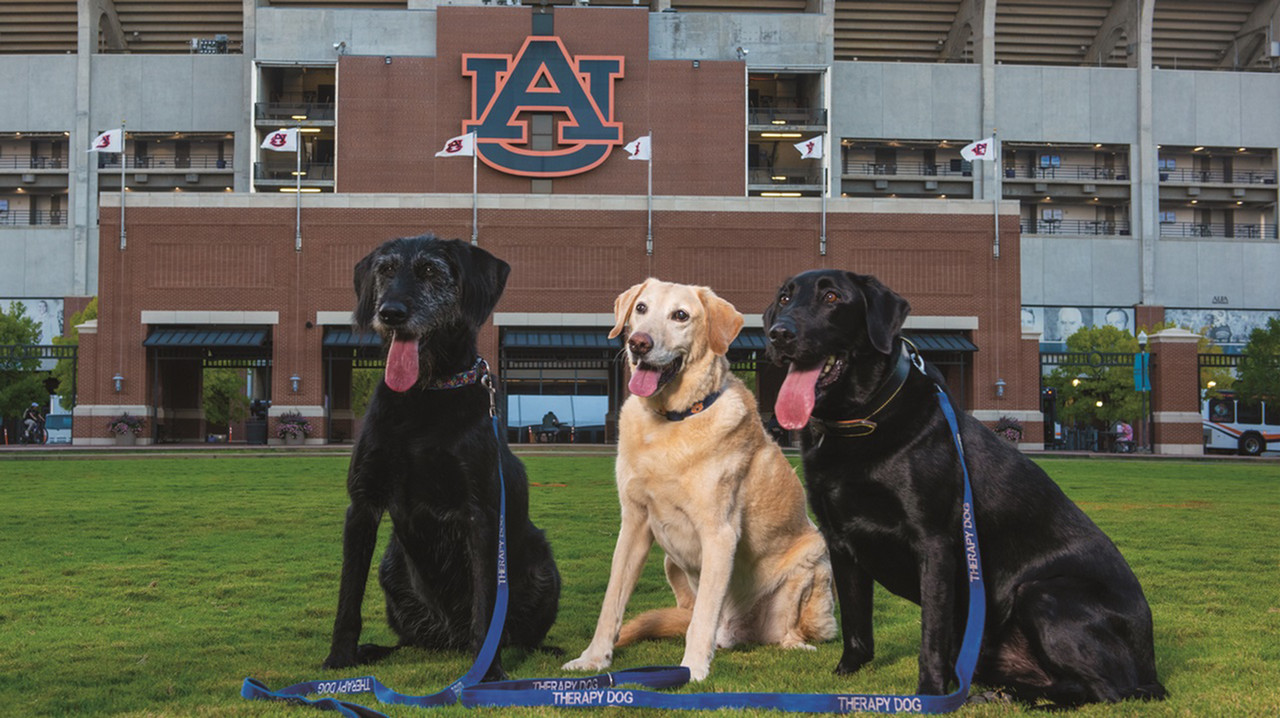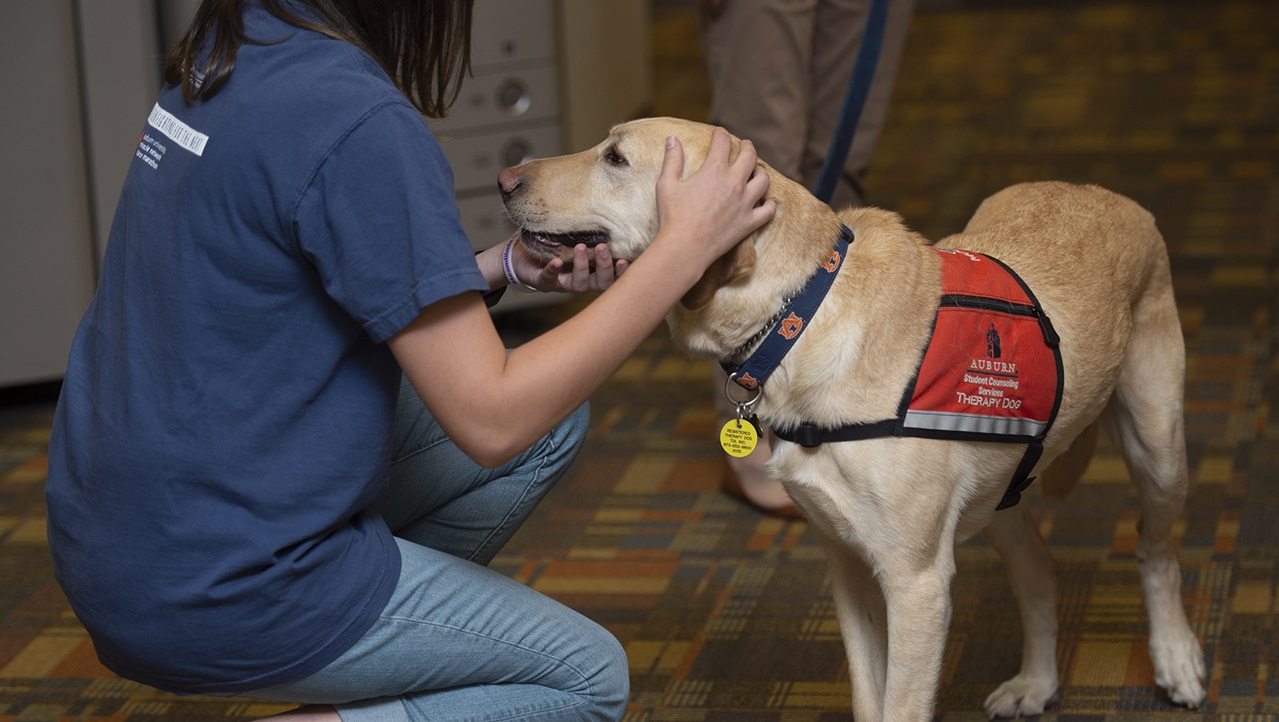content body
Student energy is back on campus, classes are underway, and a slightly cooler breeze is in the air.
And for some particularly important members of Auburn’s counseling staff, this means their job has once again kicked into high gear. These staff members have been bathed, brushed and exercised, and they stand — or sit — ready to support students just by being their joyful selves.
If you haven’t already guessed, this story is about Moose, Nessie, Rooster and Winston, the therapy dogs of the Student Counseling & Psychological Services (SCPS) staff.
“I wanted to have a therapy dog program since becoming director 17 years ago,” said Doug Hankes, SCPS executive director, “but it’s an involved process, and the sticking point was securing the commitment of a staff member.”
Why therapy dogs?
Hankes shared many benefits of a therapy dog, none of which will come as a surprise to dog owners.
Dogs show unconditional love. They have no motivations and are totally confidential. They also help guarded students feel at ease and potentially open up more to a counselor.
Dogs pick up on strong emotions; they know when to go to a student, sit with him or her and put their head in their lap. In trauma instances, petting and being around dogs helps to ground students, enabling them to share things they are working through in a calmer sense.
Hankes was well aware of the benefits, but once he had the commitment of a staff member, he needed a dog.
Will this work?
When it looked like the program would be a reality, the question quickly arose as to how the team would secure dogs for the program. Hankes considered retired greyhounds or puppies, but questions of cost and ownership lingered.
Then, Hankes’ father, Dr. Gerald Hankes, a College of Veterinary Medicine (CVM) professor emeritus, thought of partnering with CVM’s Canine Performance Sciences (CPS) to use retired service dogs.
“We liked the idea but thought there was no way this would work,” said Hankes. “They were working dogs, which required them to focus on tasks and ignore people — exactly the opposite of what you want in a therapy dog.”
Fortunately, they were wrong, and it worked brilliantly.

Drs. Nessie, Moose and Rooster, left to right, sitting in front of Auburn’s Jordan-Hare Stadium.
Working dog = therapy dog?
Enter the first dog to test the program, Dr. Moose, as he was affectionately known. Moose participated in a summer of intense training and joined the center at age 6, following his CPS retirement.
The staff quickly learned Moose wanted to do everything he could to please his handler and owner. He was used in individual and group therapy, participated in mental health and center talks and even went into residential halls during high-stress times for students.
In Hankes’ words, the dog became a “super-duper outreach ambassador” for the center.
Moose: CPS service dog to SCPS therapy dog to CVM patient
The staff member managing Moose left Auburn, and Hankes had to figure out next steps.
“God bless my wife. She welcomed Moose into our home although we already had a dog, four cats and backyard chickens,” said Hankes. “And Moose did great with everybody.”
He continued his good counseling work, and Getting Mov’in with Moose was instituted, a biweekly walk geared toward college students, encouraging mental health through movement and community.
Sadly, in 2020, Moose was diagnosed with osteosarcoma, which required amputation, but Hankes worked closely with CVM on his recovery. The school used some “new tricks,” and Moose lived another four years.
“Everyone on campus and at the vet school knew him,” said Hankes. “He was the ‘Pope of the Vet School,’ offering greetings, blessings and salutations.”
While receiving his own treatment, he touched so many people, “providing hope and support to animal owners.” Moose passed away earlier this year, but he will not soon be forgotten as his legacy lives on through this program.
Meet Nessie + Rooster
“God bless my wife again,” said Hankes, when Bart Rogers, chief canine instructor at CPS, contacted Hankes to report they had another “perfect therapy dog,” one who would become a personal dog for Hankes.
Half-black lab and half-German wire-haired pointer, Nessie joined the counseling team four years ago and will be 10 years old this year, serving students with her generous personality.
Next up was black lab Rooster, who is almost age 9 and known for the “Rooster Campfire.” Students gather around him in the waiting room, like they would a campfire, and pet his soft fur for hours.
Winston serves CVM
Mary Catherine Turner, an embedded counselor at CVM, wanted to train and certify her personal dog Winston — sometimes referred to as Dr. Winston, sometimes Winnie — as an Auburn therapy dog.
“I knew he would love being here, but I did not know he would love it as much as he does,” said Turner. “He is a goofy dog, but very serious about his job.”
Since July 2023, Winston spends his days with Turner, who is available to students, residents and interns, as well as clinicians and faculty. Turner and Winston primarily work with students in individual counseling sessions but also visit students in between classes, in study rooms and the library and at campus events.
Turner also instituted “Wind Down with Winston” in central locations, so students who are not her clients can still benefit from his therapeutic interactions.
“CVM students learn a lot about animals in their animal health care journey,” said Turner. “I think something about seeing a happy dog reminds them why they do this in the first place.”
Service dogs for the win
At the end of his interview, Hankes declares with confidence the relationship with CPS has been awesome, and this program will be part of the counseling center “from here on out.”
And to be totally cliché, it certainly appears you can teach an old dog new tricks.







